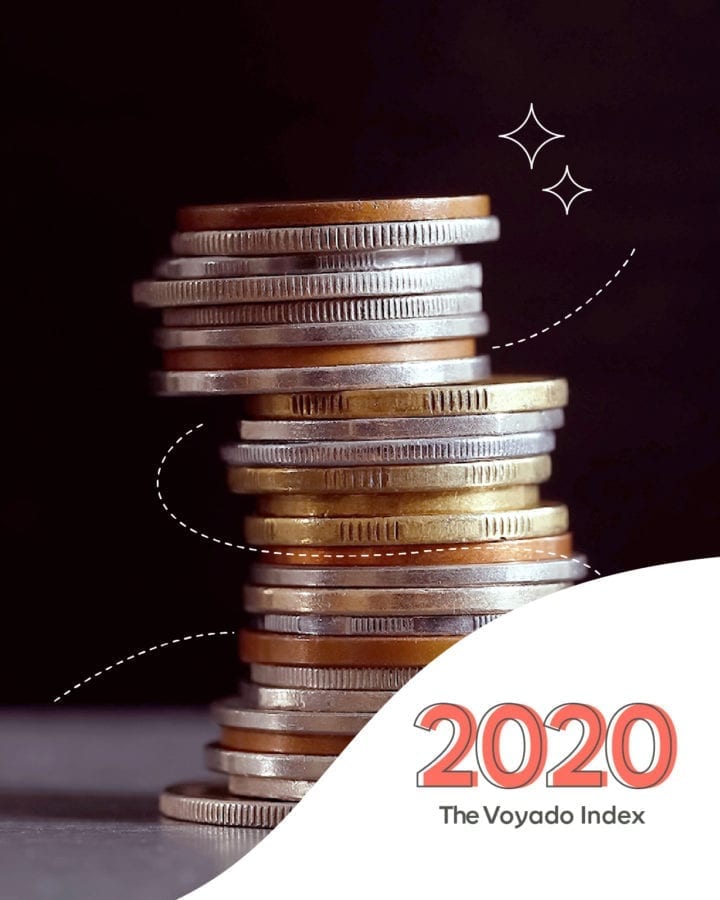Background
For anyone working in retail, knowing your customers and how they behave is crucial. Our yearly report is filled with insights based on 12 months of data, collected from five million active customers from some of Northern Europe’s largest loyalty programs* – all for you to dig into and learn about shopping behaviors 2020! We also invited a strategic analyst to share her thoughts.
When we illustrate the number of purchases, average receipt, and frequency in our graphs, we have indexed the numbers with 100 representing the average. We will show 12 different age groups, ranging from under 24 to over 75.
If you want the highlights straight away– watch this video!
Key findings from the Voyado Index
Men spend more money overall
The difference between women’s and men’s average receipts online has increased by 49.5% since last year. In physical stores, the difference has increased by 30.5%. This means that men now spend even more per purchase than women do, both in physical stores and online. This could be because men have a larger disposable income and they treat themselves when they decide to make a purchase. Compared to last year men shopped more in physical stores than online, but that has shifted and is now the opposite.
More returns online than in physical stores
136% more returns are made online than offline in 2020. Although most of the annual purchases come from physical stores – as much as 56% more. The fact that more returns are made online may be because customers are using their homes as their fitting room – they order different sizes, and they haven’t seen the products live.
Young men have 33% higher average receipts than young women
The absolute highest receipts belong to men younger than 24. Their average receipts are 33% higher than women of the same age and 36% higher than the overall average. At the same time, they have far fewer purchase occasions, 36% fewer times than the average. This may be because they buy more expensive products and save up for what they need.
What the expert says about our shopping behaviors in 2020
– Emma Heikensten, Strategic Analyst at SEB
My passion as a researcher is to find pieces of the puzzle that provide new perspectives and that reveal what reality looks like. In personal finance, it is often the slightly uncomfortable issues that we learn from the most. Therefore, it has been interesting to look at the statistics from Voyado from a private economic perspective.
It’s not about income
The reason why women shop less than men at a young age, and more than men after the age of 50, is not correlated with salary levels. Because at the beginning of careers, we see the lowest wage difference between the sexes. According to data from Statistics Sweden the largest wage differences between sexes are seen after family formation, culminating after the age of 50. And at a younger age, personal finances are often private – meaning the money is not shared with parents or partners. Therefore, the reason why young men spend more is rather related to what you choose to spend money on. The reason why women shop less than men at a young age, and more than men after the age of 50, is not about salaries.
Are younger women better at saving?
So why do young women spend less? It could be that women, to a larger extent, place money on savings and investments, but these numbers are not visible in the data. The Swedish Tax Agency’s statistics on capital gains and losses in 2018 indicate that women on the median have greater financial capital income than men up to the age of 44. That conclusion supports the theory that young women save more, and would be in line with the trend in the graph.
Can be a generational change
An interesting question is whether this is an age issue or a generational phenomenon? One possibility is that men always have (and will) spend more when they’re young and women when they’re older. Another possibility is that we see a generational change, meaning that men and women that are under the age of 50 today will continue to consume in the same way, even as they grow older. Both of these explanation models could be true, but it is not possible to know which one. It is relevant for retailers to continue to follow up on this type of statistics to plan how to communicate with different generations.
The results indicating that women after the age of 50 consume more than men are in themselves in line with international studies that suggest that women take greater responsibility for consumption in the household.
Plan together!
When discussing statistics that have to do with consumption, it’s important to remember that the things we learn from them should create a sustainable and equal society. On the individual level, it is valuable to reflect on the balance in one’s consumption, and if purchases have a resale value. In a relationship, you would both have an equal share in consumer goods as well as products that retain their value. For retailers, something constructive to bring with you is to point out to younger people in particular how your goods retain value, promote sustainability, create additional value through higher quality and build trust in the brand.
Where do customers spend the most?
The overall spend is 56% higher in physical stores than online in 2020. But omni-channel customers are still the most profitable, which shows the importance of driving customers between different channels. Apparel & Shoes has the highest return rate – 20.3 times higher than the other industries. This may be because clothes and shoes are items you want to try before you feel comfortable with the purchases. When customers shop online, they have to wait for the item to arrive at the house before they can try it on – since many of today’s customers use their homes as their fitting rooms.
Which industry wins when it comes to shopping behaviors in 2020?
Health & Beauty has the highest purchase frequency with the lowest average receipt and returns. Probably because health products generally are cheaper than items from other industries, and because you know which beauty products you like. Plus, these products aren’t anything you have to try on to see if they fit.
Customer spend based on industry and channel – Physical stores dominate, with a total turnover that’s 56% higher than online stores. It’s likely due to the number of visits which are much higher in physical stores. At the same time, we see that average receipts are higher online. The driving force behind this could be that it’s still easier to make quick purchases, hygiene articles for example, by popping into a store.
How does spending differ between genders?
In this graph, you can see how the total spending differs between men and women. It’s generally higher for men who spend more per purchase, even though women have 24.4% more purchase occasions.
How have men and women’s shopping behaviors in 2020 changed since last year?
We see that men have a stronger presence online than before. Women tend to shop more often than men still, but it’s a downward trend, with men starting to take up more and more space. Men also have a much higher average receipt, that’s grown from last year as well. Women, on the other hand, have started to increase their purchase occasions in physical stores while men have even fewer than before.
How age influences purchase behavior
Purchase behavior is highly influenced by age because it has an impact on income levels, lifestyle, and tech-savviness. 50-54-year olds have the highest purchasing power – they spend the most per year. This might be largely due to the fact that they have worked their way up to stable income levels.
Do young men buy the most expensive items?
It looks like this might be the case because there is a spike for men under the age of 24. In the graph, you can see how purchase behavior differs between age and gender. Men’s overall higher average receipts seem to be influenced especially by this young age group. Up to the age of 54, men have higher average receipts than women. After 54, we see a shift, and women spend more per purchase.
How does age affect return habits?
We see a direct correlation between age and the likelihood of returning purchased items. Those belonging to the under 24 group return significantly more than older generations.
Return habits by gender and age group
In this graph, we can see that the younger generation returns the most, even though they are said to be the most active in the fight against climate change. Perhaps you can work toward reducing returns by promoting its negative effect on the environment?

Apparel & Shoes
– Purchase channel
Compared to other industries, the turnover is quite similar for men and women in both online and in-store, however, women have more purchase occasions on both channels. The average receipt is higher for men in both channels.

– Age & gender
When it comes to age, this segment has a very similar turnover for men and women – with the only big deviation being the “under 24s”. Some of the points we made so far in this index are true in this segment – women buy smaller purchases at a higher frequency and men make fewer purchases with higher receipts.
Health & Beauty
– Purchase channel
This is the only industry where women lead the way across the board. It’s also the only industry where women have a higher receipt, both online and in-store.

– Age & gender
We see a high spike for men under 24 when it comes to average receipt. Other than that, turnover and visits increase with age, suggesting perhaps that the older generations are very loyal to their favorite stores when it comes to health and beauty.
Home Improvement
– Purchase channel
Men spend more when it comes to home improvement, and also visit online stores more often than women. Interestingly, women make more visits to home improvement’s physical stores.

– Age & gender
We see that purchase occasions increase with age and that the opposite is true for average receipt. This suggests that the younger age groups save up to buy what they really want and need when it comes to home improvement.
Sporting goods & Hobby
– Purchase channel
Perhaps unsurprisingly, men spend significantly more in this industry compared to women. Women visit physical stores often, but men have a nearly double average receipt.

– Age & gender
The oldest generations like to visit their favorite sporting and hobby store! They don’t spend as much per visit though, turnover and average receipt peak in the 50s age group.
We hope that this has given you a lot of great insights that you can use for your strategies moving forward. If you want to download and save the index report and get all the graphs – you’ll find it here.
*Note! These numbers of shopping behaviors 2020 are taken from before the Covid-19 pandemic started. As seen in our Covid-19 edition of the index, released earlier this year, we see that the numbers differ slightly during these times.












